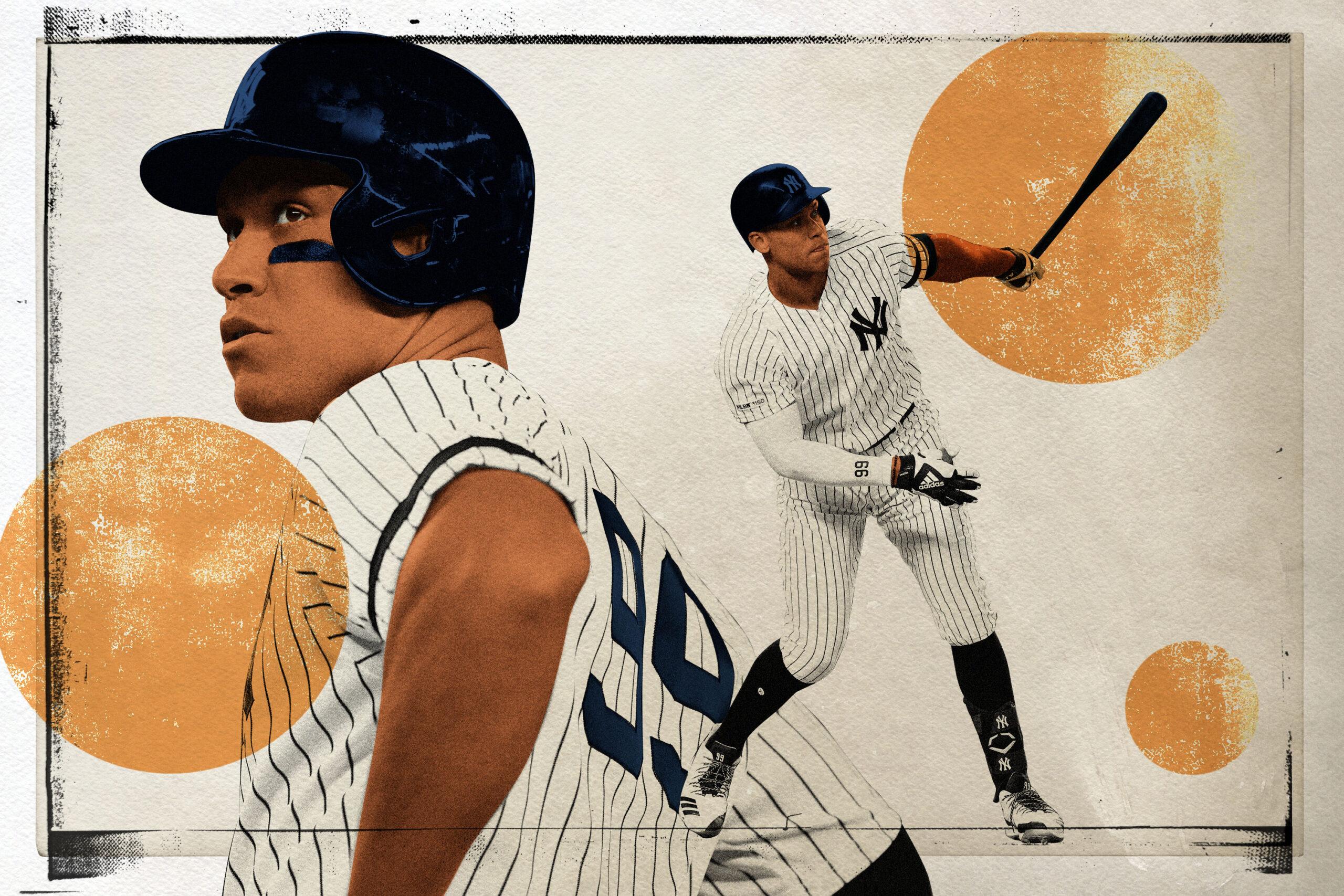
Two years ago this week, Aaron Judge was mired in the most severe playoff slump imaginable. In 24 plate appearances against Cleveland in the 2017 ALDS, he recorded one measly hit against an astounding 16 strikeouts. To that point, nobody in MLB history had struck out more than 13 times in a single playoff series. (Cody Bellinger would best Judge with 17 in that year’s World Series, but that total came over seven games instead of Judge’s five.)
So with that opening act in mind, this statistic might come as something of a surprise. Here are the top OPS marks in playoff history for players with at least 90 career postseason plate appearances:
Best Postseason Batters in MLB History (Min. 90 PA)
Only a dozen players are ahead of Judge, eight of whom are present or future Hall of Famers. Overall, Judge is slashing .263/.391/.592 in his playoff career, and that’s with those terrible Cleveland stats accounting for more than a quarter of his plate appearances. He’s hit at a Ruthian level since that 2017 ALDS—.327/.444/.731, for a 1.175 OPS—to compensate.
In the Yankees’ just-completed sweep of the Twins in this year’s division series, Judge displayed how far he’s come against playoff pitching. Across three games, he led the club in on-base percentage (.538) and recorded four walks versus only one strikeout. He wasn’t an insatiable slugger, but rather served as a table-setter in a deep Yankees lineup. Judge, the no. 2 hitter, and DJ LeMahieu, the leadoff man, combined to score as many runs (seven) as the entire Minnesota team.
He will need to maintain those gains against whatever opponent the Yankees face in the ALCS: The Astros and Rays employed the two best pitching staffs in the American League this season, jointly ranking first and second in the AL in ERA, FIP, xFIP, strikeout rate, swinging-strike rate, and all three slash line categories: batting average allowed, OBP allowed, and slugging percentage allowed. Either team will pose a more significant challenge to New York’s lineup than Minnesota’s staff. The good news for Judge is that he can now hit playoff pitching virtually every night.
It was likely always this way, of course; the lesson from that OPS leaderboard is that the best postseason hitters tend to be the best regular-season hitters too, and Judge is certainly one of the best regular-season hitters around. Still, the concern two years ago was that Cleveland had solved something in the then-rookie and, in a “one weird trick!” kind of way, figured out how to silence his powerful bat.
Mainly, Corey Kluber, Carlos Carrasco, and friends tormented him with sliders, lots of them, which led to copious whiffs on unhittable pitches outside the strike zone. For a week, the most important of his MLB career to that point, Judge simply couldn’t lay off. He had actually started his playoff career with a bang, homering against Minnesota in the 2017 wild-card game. But in those five matchups against Cleveland, he hit .050/.208/.100 and missed 16 times on 21 swings against breaking pitches.
That deficiency hasn’t persisted, even when facing the best pitching staffs in the American League. Against four playoff opponents since Cleveland in 2017—including Houston, in that year’s ALCS—Judge has cut his whiff rate, missing on 19 of 37 swings against breaking balls, and improved immensely with hard contact against those pitches. In that first, slumpy series, Judge managed a .068 weighted on-base average (OBP, but with extra-base hits counting for extra points) against breaking balls and a .053 expected wOBA based on Statcast batted-ball info. (Of course, with 16 whiffs in 21 swings, there wasn’t much batted-ball info to go around.) Since that series, those numbers are a robust .423 and .444, respectively. Judge even solved the slider in a key moment, turning on a Ken Giles offering in the middle of the Yankees’ Game 4 comeback in the 2017 ALCS to thud a double off the wall.
While regression from such an extreme week as the one Judge had against Cleveland is to be expected, there might also be an explanation for his newfound playoff success in another split. Although his overall numbers since his Rookie of the Year season have dipped—which isn’t saying much; anyone not named Mike Trout would have regressed from Judge’s 2017 stats—he’s fared better over the last two seasons when facing the league’s best pitchers. Baseball-Reference splits pitchers into “power” and “finesse” categories; the former rank among the top third of the league in strikeouts plus walks, while the latter rank in the bottom third. That’s not a perfect proxy for pitcher quality, but it’s possible (if of uncertain value) that a player’s performance against power pitchers could better approximate the expectation for October hitting, as seemingly every playoff pitcher now is either an elite starter or a reliever with a high strikeout rate.
As a rookie, Judge feasted on bottom-tier pitchers even more than the rest of the league did. He hit 112 percent better than the MLB average against finesse pitchers, versus only 15 percent better than average against power pitchers. Since 2017, however, those marks have evened out, and relative to the rest of the league Judge is better against power than finesse arms. In other words, he is now better in the regular season against the kinds of pitchers he’s more likely to face in the playoffs, while losing some value against the players who typically don’t pitch in October anyway.
Aaron Judge’s Percent Better Than Average, by Pitcher Type
In any case, it’s hard to argue with the results. Judge homered in his first three games of the 2018 playoffs: In the first inning against Oakland in the wild-card game; in the ninth inning, off Craig Kimbrel in a save situation, in Game 1 of the ALDS in Boston; and then in the first inning of Game 2 at Fenway Park the next afternoon. And though he hasn’t homered yet in the 2019 postseason, nobody on the Yankees is upset with a player who’s reached base more than half of the times he’s come to the plate.
Even more impressively, since the Cleveland series, Judge has struck out just 15 times in 64 postseason plate appearances—23 percent, which is lower than his career regular-season rate of 31.6 percent. Pitchers throw harder and strike out more batters in the playoffs than they do in the regular season, and over the last decade, postseason OPS has declined by an average of 43 points compared with the regular season. (So far this season, that OPS gap is at 32 points.) But Judge has struck out less, homered more, and posted a better OPS in the postseason than he has in the regular season. Against the league’s best pitchers, he’s improved.
Granted, a total of 92 plate appearances in 21 games, let alone the smaller number since the 2017 Cleveland series ended, amounts to less than one month of play in the regular season. The simplest explanation for Judge’s emergence as a historically great playoff hitter is that he’s a historically great regular-season hitter, too, and he probably won’t continue to outperform his regular-season self.
All of this analysis—and all playoff analysis, really—involves small samples. So does this statistic, some version of which might appear on TV screens if Houston advances past Tampa Bay to the ALCS: Against the Astros’ four most important pitchers, all righties—Justin Verlander, Gerrit Cole, Zack Greinke, and closer Roberto Osuna— Judge has combined to post a career slash line of .063/.118/.156, with 17 strikeouts and just one extra-base hit in 34 plate appearances. His on-base percentage against Verlander (.158) is his lowest against any pitcher he’s faced at least 10 times.
That history sounds worrisome for Yankees faithful, but the good news for Judge is that batter-vs.-pitcher stats show no predictive power, and Judge himself demonstrated the folly of such data points earlier this season. Before 2019, Judge had gone 0-for-13 in his career against Verlander with seven strikeouts; he went single-walk-homer in his first three plate appearances against the Astros righty during their matchup in April.
And the funniest aspect of Judge’s playoff history is that his most impactful play likely didn’t come with the bat at all. In Game 3 of the 2017 ALDS, a contest in which Judge struck out three times in four plate appearances as the Yankees tried to stave off elimination, a critical moment came in the sixth inning. With the game scoreless and one runner on base, Francisco Lindor lofted a fly ball toward Yankee Stadium’s shallow right field fence. Judge jumped and robbed the potential series-winning home run; the Yankees eventually won the game 1-0, and the series 3-2.
Indeed, Judge has been just as adept with his glove as his bat during the postseason. In this year’s sweep of the Twins, for instance, he added a full reel of defensive highlights. In Game 1, he made a pair of diving catches, the second with a runner on second and two outs; in Game 3, the mere threat of his arm held Jake Cave to a single after the Minnesota outfielder thwacked a line drive off the right field wall. And Judge leaped to take extra bases away from Miguel Sanó with another runner on second on Monday night.
Perhaps because of his better-celebrated offensive prowess, or perhaps because of his size, Judge is generally underappreciated for this side of his skill set: He is the majors’ second-best defensive right fielder, behind only division rival Mookie Betts.
“Mookie Betts is a center fielder playing right field great in a tricky right field in Fenway,” Brett Gardner—once a top-of-the-league outfielder himself—told New York Post reporter Joel Sherman this week. “And I am telling you that because that is the reason [Judge] is not winning Gold Gloves. And Mookie is deserving. But [Judge] is deserving too.”
Judge led Betts (and all MLB right fielders) in some defensive metrics in 2019, but advanced defensive stats are more erratic and less reliable than their offensive counterparts. Luckily for Judge, the numbers all agree that he’s played his position impeccably for years, even if not quite at Betts’s level. Over the last three seasons, Judge ranks third among all qualified fielders in ultimate zone rating per 150 appearances, behind only Betts and Andrelton Simmons, and just ahead of other acknowledged all-world fielders Matt Chapman and Lindor. In Defensive Runs Saved, Judge is tied for sixth among noncatchers. Both systems rate him favorably for both his range and his arm.
Unlike other elite outfielders, Judge has a below-average “jump” when tracking tricky fly balls, but he takes intelligent routes and has a bit of extra leeway thanks to his size, which gives him uncommon extension on dives and lunges. Just watch the Sanó robbery again to see how useful a 6-foot-7 outfielder can be when that size doesn’t compromise movement.
Even when Judge is not contributing at the plate, then, he remains a productive player in the New York lineup. In the clinching Game 3 against Minnesota, he reached base just once (on a catcher’s interference) and didn’t score a run. But he saved at least one score, if not more, with his glove, after torching the Twins at the plate in both games in the Bronx.
The Yankees will need their franchise player to flash both award-worthy sides of his game in the next round, and the round beyond, if they are to win their first championship in a decade. Judge is no longer a curiosity for his playoff failures. Now he’s just another superstar performing well when the games matter most.

